| matplotlib Inset Locator Demo. |
H.Kamifuji . |
- Inset Locator Demo
inset_locator の inset_axes を使用すると、幅と高さを指定することで簡単にインセットを軸の角に配置できます。また、Legend と同様に、位置をコードとして受け入れる位置(loc)を指定できます。 デフォルトでは、インセットは、borderpad パラメータによって制御される軸からのいくつかのポイントによってオフセットされます
import matplotlib.pyplot as plt from mpl_toolkits.axes_grid1.inset_locator import inset_axes fig, (ax, ax2) = plt.subplots(1, 2, figsize=[5.5, 2.8]) # Create inset of width 1.3 inches and height 0.9 inches # at the default upper right location axins = inset_axes(ax, width=1.3, height=0.9) # Create inset of width 30% and height 40% of the parent axes' bounding box # at the lower left corner (loc=3) axins2 = inset_axes(ax, width="30%", height="40%", loc=3) # Create inset of mixed specifications in the second subplot; # width is 30% of parent axes' bounding box and # height is 1 inch at the upper left corner (loc=2) axins3 = inset_axes(ax2, width="30%", height=1., loc=2) # Create an inset in the lower right corner (loc=4) with borderpad=1, i.e. # 10 points padding (as 10pt is the default fontsize) to the parent axes axins4 = inset_axes(ax2, width="20%", height="20%", loc=4, borderpad=1) # Turn ticklabels of insets off for axi in [axins, axins2, axins3, axins4]: axi.tick_params(labelleft=False, labelbottom=False) plt.show()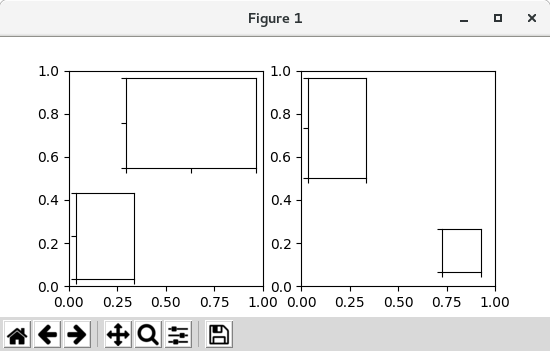
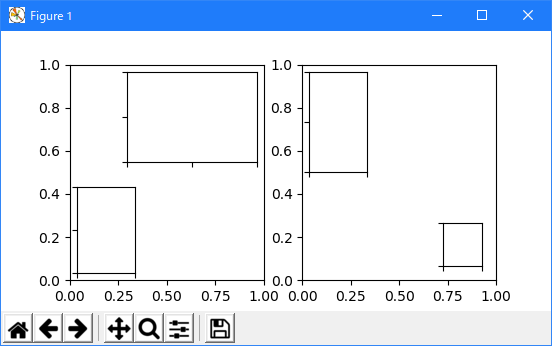
引数 bbox_to_anchor と bbox_transfrom を使用すると、挿入位置とサイズをより細かく制御したり、完全に任意の位置に挿入位置を配置したりすることができます。 bbox_to_anchor は、bbox_transform に従ってバウンディングボックスを座標で設定します。
import matplotlib.pyplot as plt from mpl_toolkits.axes_grid1.inset_locator import inset_axes fig = plt.figure(figsize=[5.5, 2.8]) ax = fig.add_subplot(121) # We use the axes transform as bbox_transform. Therefore the bounding box # needs to be specified in axes coordinates ((0,0) is the lower left corner # of the axes, (1,1) is the upper right corner). # The bounding box (.2, .4, .6, .5) starts at (.2,.4) and ranges to (.8,.9) # in those coordinates. # Inside of this bounding box an inset of half the bounding box' width and # three quarters of the bounding box' height is created. The lower left corner # of the inset is aligned to the lower left corner of the bounding box (loc=3). # The inset is then offset by the default 0.5 in units of the font size. axins = inset_axes(ax, width="50%", height="75%", bbox_to_anchor=(.2, .4, .6, .5), bbox_transform=ax.transAxes, loc=3) # For visualization purposes we mark the bounding box by a rectangle ax.add_patch(plt.Rectangle((.2, .4), .6, .5, ls="--", ec="c", fc="None", transform=ax.transAxes)) # We set the axis limits to something other than the default, in order to not # distract from the fact that axes coodinates are used here. ax.axis([0, 10, 0, 10]) # Note how the two following insets are created at the same positions, one by # use of the default parent axes' bbox and the other via a bbox in axes # coordinates and the respective transform. ax2 = fig.add_subplot(222) axins2 = inset_axes(ax2, width="30%", height="50%") ax3 = fig.add_subplot(224) axins3 = inset_axes(ax3, width="100%", height="100%", bbox_to_anchor=(.7, .5, .3, .5), bbox_transform=ax3.transAxes) # For visualization purposes we mark the bounding box by a rectangle ax2.add_patch(plt.Rectangle((0, 0), 1, 1, ls="--", lw=2, ec="c", fc="None")) ax3.add_patch(plt.Rectangle((.7, .5), .3, .5, ls="--", lw=2, ec="c", fc="None")) # Turn ticklabels off for axi in [axins2, axins3, ax2, ax3]: axi.tick_params(labelleft=False, labelbottom=False) plt.show()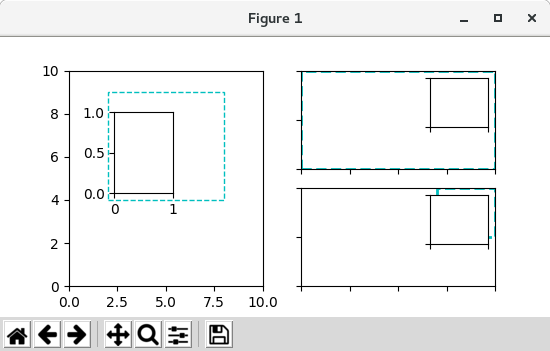
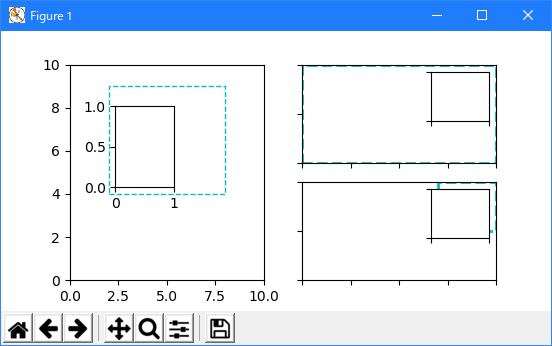
上の例では、4 タプルのバウンディングボックスと共に軸変換を使用しています。これは、インセットされている軸を基準にしてインセットを指定するのに便利です。 しかし、他のユースケースも同様に可能です。 次の例は、それらのいくつかを調べます。
import matplotlib.pyplot as plt from mpl_toolkits.axes_grid1.inset_locator import inset_axes fig = plt.figure(figsize=[5.5, 2.8]) ax = fig.add_subplot(131) # Create an inset outside the axes axins = inset_axes(ax, width="100%", height="100%", bbox_to_anchor=(1.05, .6, .5, .4), bbox_transform=ax.transAxes, loc=2, borderpad=0) axins.tick_params(left=False, right=True, labelleft=False, labelright=True) # Create an inset with a 2-tuple bounding box. Note that this creates a # bbox without extent. This hence only makes sense when specifying # width and height in absolute units (inches). axins2 = inset_axes(ax, width=0.5, height=0.4, bbox_to_anchor=(0.33, 0.25), bbox_transform=ax.transAxes, loc=3, borderpad=0) ax2 = fig.add_subplot(133) ax2.set_xscale("log") ax2.axis([1e-6, 1e6, -2, 6]) # Create inset in data coordinates using ax.transData as transform axins3 = inset_axes(ax2, width="100%", height="100%", bbox_to_anchor=(1e-2, 2, 1e3, 3), bbox_transform=ax2.transData, loc=2, borderpad=0) # Create an inset horizontally centered in figure coordinates and vertically # bound to line up with the axes. from matplotlib.transforms import blended_transform_factory transform = blended_transform_factory(fig.transFigure, ax2.transAxes) axins4 = inset_axes(ax2, width="16%", height="34%", bbox_to_anchor=(0, 0, 1, 1), bbox_transform=transform, loc=8, borderpad=0) plt.show()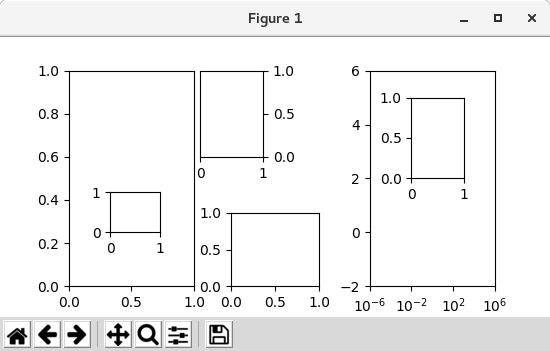

- 参照ページ
Inset Locator Demo
- リリースノート
- 2023/03/12 Ver=1.03 Python 3.11.2 で確認
- 2020/10/28 Ver=1.01 Python 3.7.8 で確認
- 2018/11/08 Ver=1.01 初版リリース
- 関連ページ